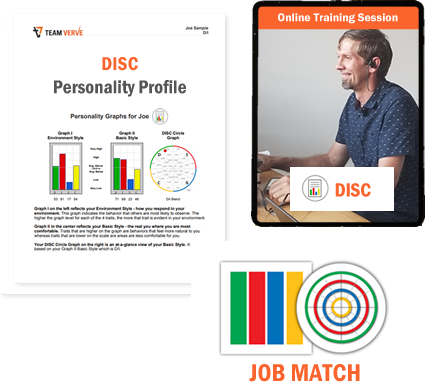Hiring new employees—while maintaining a healthy team culture—is an immense and challenging responsibility for even the most seasoned leaders. Adding key equipment to your recruiting toolbox, like using DISC for hiring and onboarding, can yield great results!
Hiring and Onboarding with Intention
Finding, hiring, and onboarding ideal candidates successfully requires thoughtful pre-work before any hiring campaign gets underway.
Hiring managers need…
- A well-defined understanding of the role being filled and its value to the company
- A thorough-yet-concise job description for the role
- A clarity about the extent to which each new hire might affect company culture
Are your leaders crystal-clear on the types of employees you wish to attract and the expectations your culture is building? If not, head back to the drawing board on the above list!
Additionally, what shared language does your organization use to express these values and expectations? How can new employees learn that language quickly and accurately so they understand how they fit in the team?
Useful Hiring Assessment Tools
We often hear of job candidates being administered assessments—like DISC—as part of the recruitment process. These assessments can be helpful tools in discerning key aspects of a candidate’s work or communication styles.
As your recruiters look for potential hires who fit well with the job’s description and requirements, the DISC Hiring Bundle can help describe an ideal candidate for the position.
At interview time, that simple DISC assessment can assist the hiring team with crafting strong interview questions based on each applicant’s predictable strengths and weaknesses. Sample questions to add to your interview guide might be,
- “Do you see this as one of your strengths? How could this play out on the job?”
- “Do you think this is actually one of your weaknesses? How can our team help you in this area?”
DISC can also help you understand a candidate’s work style a bit better and discern if the typical requirements of the role fall within their comfort zone. Be cautious about pigeonholing or typecasting job seekers, however. You may be surprised by hidden skills and talents best uncovered through unbiased, thoughtful conversations.
Additionally, DISC can help bring aboard styles to balance out an existing team or advance a particular project. It is a useful tool to help you build your bench for success!

Intentional Onboarding Practices
According to recent Gallup studies, only 12% of new hires felt their onboarding experience was adequate. Today, more than ever, a clear, enjoyable, and intentional onboarding process is crucial to retaining employees and protecting healthy work culture.
Companies who are already using DISC with their teams can tailor certain aspects of onboarding (and even pre-boarding, that phase between job acceptance and the employee’s first day) to suit a new hire’s learning style and communication needs. A New Team Member Bundle provides key tools for this!
DISC provides common ground and shared language as teams get to know the newest team member. As that new teammate acclimates to a new daily routine, conversations about company and shared team culture can happen organically in the context of discussing how the team’s goals are influenced by their DISC styles.
Likewise, managers who disclose their own DISC results with new hires—and who welcome discussion about preferred communication and work styles—can build trust and loyalty with these new team members more quickly and effectively.
The Right Bus, the Right Seat
Once you’ve discovered your team’s newest star, hired and onboarded them with intentionality and care, then what?
Now comes the work of making sure your new great-fit employee is in the right seat on the right bus, to help them achieve their best and to maintain your company’s healthy team culture.
Patrick Lencioni, in a nod to Jim Collins’ book Good to Great, refers to this bus metaphor to help leaders understand that they must thoughtfully take care of the “Who” in order to effectively manage the “Where” (the organization’s trajectory) and the “What” (the solutions to be discovered along the way).
Taking an organization’s mission and legacy to new heights involves leaders being intentional about hiring, firing, onboarding, and role structuring for success.
Consider your “A Level” personnel—those employees who would walk through fire or flood for your organization, your clients/shareholders, and your team.
- Are they achieving success in their roles?
- Could they push your organization’s mission to greater heights if they moved to a different bus seat?
- What if another A Player joined them in the adjacent bus seat—what could they achieve together for the greater good?
Do you need to find more of these great-fit employees for your bus? Remember that a DISC assessment is just the start to finding your next shining star!
Using DISC for Hiring and Onboarding
DISC is just one tool to keep in your recruitment toolbox for intentional hiring and onboarding. It is also useful for placing your team members in their right-seat roles. Use DISC as a tool to build your team. We are cheering you on!
Additionally, DISC can be put to work in other contexts—to give more specific feedback and ask better questions, to understand the preferences and concerns of your customers, to build on the strengths of your employees and work through differences, to talk about hard things, and to build a culture of trust in your team.
If you have questions about any of these DISC tools, we are glad to point you in the right direction. Chat with Matt or check out DISC training workshops.




